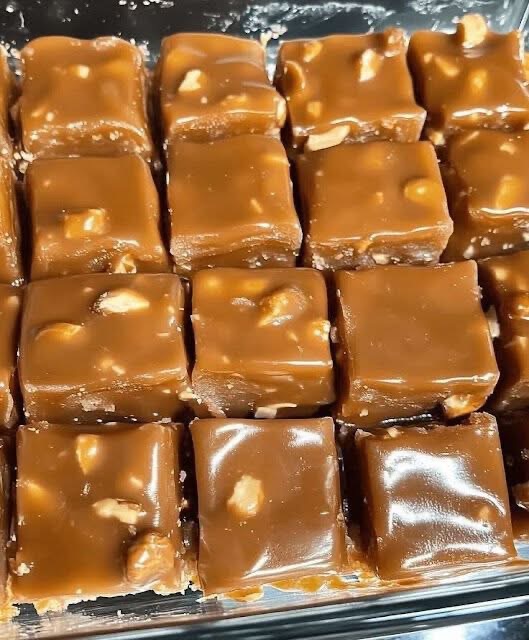
This heritage candy captures the warmth and richness of old-fashioned confectionery. Born from the heart of Oklahoma kitchens, these caramel squares combine simple ingredients—cream, sugar, butter, and nuts—into a luxurious treat that evokes nostalgia. The process is slow and steady, just like generations of candy-makers who stirred over stovetops until the caramel reached that perfect golden hue. Each bite is a balance of creamy sweetness and nutty crunch, wrapped in the comforting aroma of caramelized sugar. It’s a candy meant to be shared, gifted, and cherished.
History and Tradition
Oklahoma Nut Candy dates back to early 20th-century American kitchens, where homemakers transformed pantry staples into luxurious sweets for holidays and gatherings. Sugar and cream were precious commodities, and recipes like this one were reserved for special occasions. The technique—slow caramelization followed by careful blending—was considered a hallmark of skill. Passed down through handwritten recipe cards, this candy remains a symbol of homemade generosity and southern hospitality.
Ingredients
2 cups heavy cream
6 cups granulated sugar, divided (2 cups + 4 cups)
1/2 cup (113 g) unsalted butter
1 teaspoon vanilla extract
1/4 teaspoon baking soda
1 1/2 cups chopped walnuts or pecans (toasted for richer flavor)
Pan size: 9×13-inch gives 1-inch squares, or use 8×12-inch for thicker pieces.
Preparation Method
Begin by preparing your candy pan. Lightly grease a 9×13-inch baking dish and set it aside where it’s easy to pour later. In a small, heavy saucepan, place 2 cups of sugar over low heat. Stir often, watching carefully as it melts slowly into a smooth, amber liquid. This stage takes patience—about 15 to 20 minutes—but the result is a deep, aromatic caramel base. In another large saucepan, combine the remaining 4 cups of sugar with the heavy cream. Warm the mixture gently, stirring until all the sugar dissolves. Once the cream mixture is smooth and warm, carefully pour the melted sugar into it in a thin stream, stirring constantly to blend the two. Raise the heat to medium and continue stirring as the candy cooks. Use a candy thermometer and watch for the mixture to reach 244°F (118°C), known as the softball stage.
When the temperature is perfect, remove the pan from heat. Immediately add the baking soda—expect it to foam—followed by the butter and vanilla extract. Stir until the butter melts completely and the mixture becomes glossy and uniform. Let the caramel rest undisturbed for about 20 minutes so it thickens slightly. Then stir in the chopped walnuts or pecans, mixing just until the gloss fades and the nuts are evenly coated. Pour the candy into the prepared pan, smoothing the top with a spatula. Allow it to cool completely—this may take 1–2 hours or overnight for the best texture. Once firm, cut it into neat squares with a sharp knife.
Troubleshooting & Tips
A gritty texture often results from undissolved sugar. Ensure the sugar is fully melted before the boiling stage, and use a pastry brush dipped in water to wash down any crystals forming on the sides of the pan. If your candy turns out too soft, it was likely undercooked; too firm or crumbly means it was cooked a bit too long. Always aim for exactly 244°F. Toasting the nuts for 6–8 minutes at 350°F (175°C) enhances their flavor and aroma, adding depth to each bite. Remember, molten sugar is extremely hot—use a long-handled spoon and keep your workspace safe from distractions.
Nutritional Insight
Each small square delivers energy, calcium from the cream, and beneficial fats from the nuts. Though rich in sugar, moderation turns this treat into a delightful indulgence rather than an excess. Walnuts and pecans add omega-3 fatty acids and antioxidants, offering a wholesome touch to an otherwise decadent sweet.
Benefits and Enjoyment
Beyond its taste, Oklahoma Nut Candy celebrates craftsmanship and connection. Making it teaches patience, precision, and respect for tradition. It’s perfect for gifting, wrapping beautifully in wax paper or small boxes for friends and family. The candy also stores well, keeping its flavor for weeks when sealed in an airtight container.
Formation and Texture
The finished candy should be silky yet firm, cutting cleanly into glossy squares. The nuts add both texture and character, giving each piece a rustic charm. The caramel base is creamy, never sticky, and the balance between sweetness and nuttiness makes it irresistible.
Conclusion
Oklahoma Nut Candy stands as a timeless confection—a tribute to the art of slow cooking and simple ingredients. It reflects the warmth of home kitchens, the joy of sharing sweets made by hand, and the enduring comfort of caramel and nuts. Whether served during the holidays, shared among friends, or enjoyed quietly with a cup of coffee, each square carries a little taste of history and heart.
Candy Lovers’ Note
This recipe is more than dessert; it’s a tradition. Toffee and caramel lovers alike will appreciate its rich depth and velvety texture. Those who savor the nostalgia of homemade sweets will find in this candy not just flavor, but memory—an edible heirloom passed from one generation of candy lovers to the next.